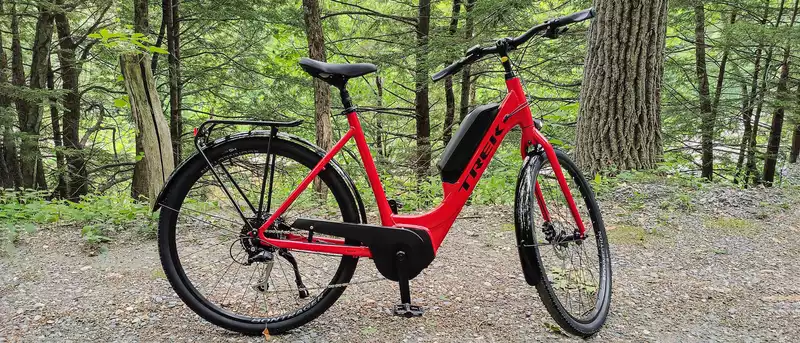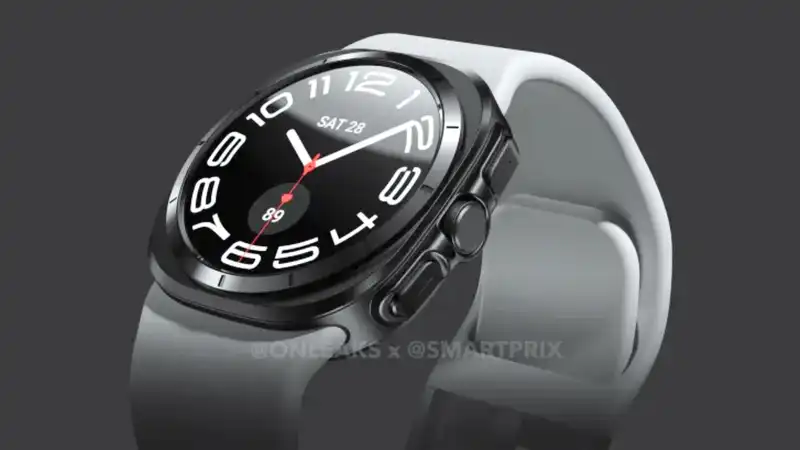The Trek Verve+ 2 is probably a bit underpowered for most riders compared to budget electric bicycles such as Rad Power, Juiced Bikes, and Aventon. On the other hand, if those electric bikes are somewhat rugged and you want something more subtle, this mild-mannered electric bike may be just right for you.
Designed for daily commuting and weekend day trips, the Trek Verve+ 2 doesn't make any radical design or excessive power claims. This road bike is for those who want a hassle-free, easy-to-maintain easy-rider with reliable components. In fact, the low-step version of the Verve+ 2 we tested is even easy to get on.
Founded in Wisconsin in the 1970s, Trek has a reputation for solid construction and reliability. Sold through retailers, Trek's lineup ranges from $13,000 carbon fiber road racers to full suspension mountain bikes.
The $2,849.99 Verve+ 2 falls in the middle of the company's e-bike lineup. Trek's Domane+ ALR, for example, starts at $5,049.99, while the Townie Go 8D EQ Step-Over is a more serious distance road bike starting at $2,449.99.
Trek bikes cannot be purchased directly online, but are ordered through retailers. The advantage is that you don't have to skin your fingers when you assemble them yourself.
Trek's Verve+ 2 is designed for casual riders and commuters. It is available in sizes XS through L, with the largest size accommodating riders just over 6 feet tall. The aluminum frame, steel fork, and wide, straight handlebars make it comfortable for commuting, and while the Verve+ 2 doesn't have a mountain bike-style front shock, the foam Bontrager seat with suspension seatpost takes the edge off potholes.
Trek also includes a chain guard that runs almost the entire length of the bike to prevent your nice pants or skirt from getting messed up in gear. In addition, essential power and brake wires are routed through the downtube to keep them tidy and reduce the chance of damage. For convenience, quick-release wheels are provided front and rear.
Power assist is provided by a Bosch Active Line 250-watt mid-drive motor. The bike has a pedal-assist top speed of 20 mph and is powered by a Bosch controller, a Shimano 9-speed drivetrain, and a 400 Wh removable battery. The bike is equipped with hydraulic disc brakes, puncture-resistant tires, a kickstand, front and rear lights, and metal fenders.
The Verve+ 2 also includes a rear rack with a Racktime clip-on system for easy use of compatible panniers and bags. A headlight and taillight are included, but no bell or horn are included.
The Trek Verve+ 2 offers smooth electric-assisted pedal performance and predictable handling. It is also relatively lightweight (52 lbs. vs. 70 lbs.), making it highly maneuverable and allowing the rider to feel in control of the bike.
Although there is no full-throttle mode, the torque-sensing mid-drive motor is very responsive in the city. The moment the driver applies force to the pedals, he or she receives electric assistance. This makes it more seamless than many rear hub motor models, which tend to suffer from delays and turbo lag. As a result, the Trek Verve+ 2 helps the rider start from a stop and is whisper quiet compared to rear-motor versions. To bring everything to a stop, the bike's hydraulic brakes are responsive without being too touchy.
Bringing the Trek into the countryside was more difficult. The mild power assist, even in top turbo mode, felt inadequate for climbing hills. Also, if you are in the wrong gear on a hill, you will get up out of the saddle. So if you need help on the hills of San Francisco or Asheville, hit somewhere else.
One of the advantages of the Verve+ 2 is that it can be used in full manual mode. You don't need electric support; compare it to larger gravel bikes like the Aventon or Biktrix.
The Bosch controller for the electric assist displays speed, range, selected amount of electric assist, and remaining battery power. There is also a button for walk mode, but unless you are pushing the bike up a steep hill, you are unlikely to need it.
Also, the front headlamp could be a bit brighter for daytime visibility (I didn't notice it was on initially).
The Bosch controller on the Verve + 2 is a basic LCD display with four power assist modes to choose from: Turbo, Sport, Tour, and Eco. According to Trek, the Eco mode has a maximum range of 60 miles, and the Turbo mode has a range of 25 miles, with the higher amount of electric assist reducing the range.
We found the lower power mode to be less useful on hills, so we used Turbo mode primarily during our weeks of testing. Facing considerable hills and with a 170-pound rider on board, the average range was 23 miles when using turbo mode. Given the tough terrain, this would be a reasonable result. However, depending on where one rides, one's weight, and one's preference for electric assist, one's mileage may vary.
If you are looking for an e-bike between $1,400 and $1,900, there are many $1,799 e-bikes available from reputable but relatively new manufacturers such as Rad Power Rad City5 Plus and Charge Bikes City. In this market, you get more power for your money, but they generally use less desirable rear hub motors and are heavier for gravel and occasional off-road use.
If you are considering the more suburban-oriented Trek Verve +2 and can afford $2,800, there are plenty of options from other well-known brands. Cannondale, for example, offers the Adventure Neo 4, which boasts nearly the same powertrain and feature set, for the same price. However, Cannondale's model is better styled than Trek's bike, with the battery hidden as part of the downtube.
And if you want a truly hassle-free and sleek e-bike commuter, our first choice, though considerably more expensive ($4,249), is still the Gazelle Ultimate C380 HMB.
It's hard to argue with the value of the Trek Verve+ 2. There are many of the Best Electric Assist Bikes and Best Cheap Electric Assist Bikes with comparable capabilities and much more power available for much less money. On the other hand, light casual riders will find the Verve+ 2 easier to handle and maneuver than those cheaper models. Moreover, Trek sells its bikes in brick-and-mortar stores as opposed to online direct sales models, so buyers don't have to face the hassle of assembling the bike themselves.
.









Comments